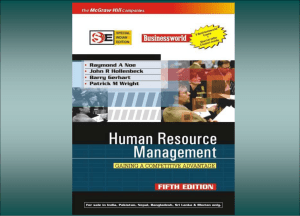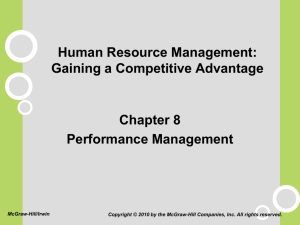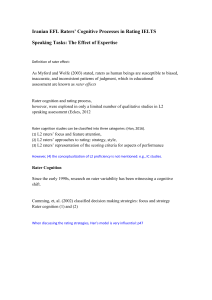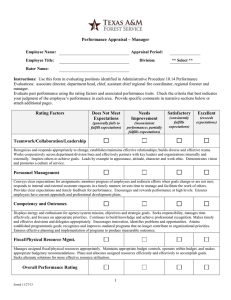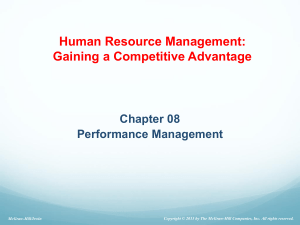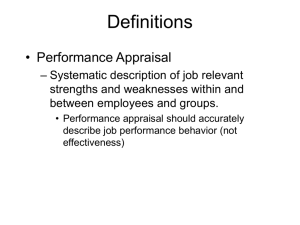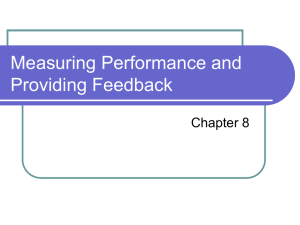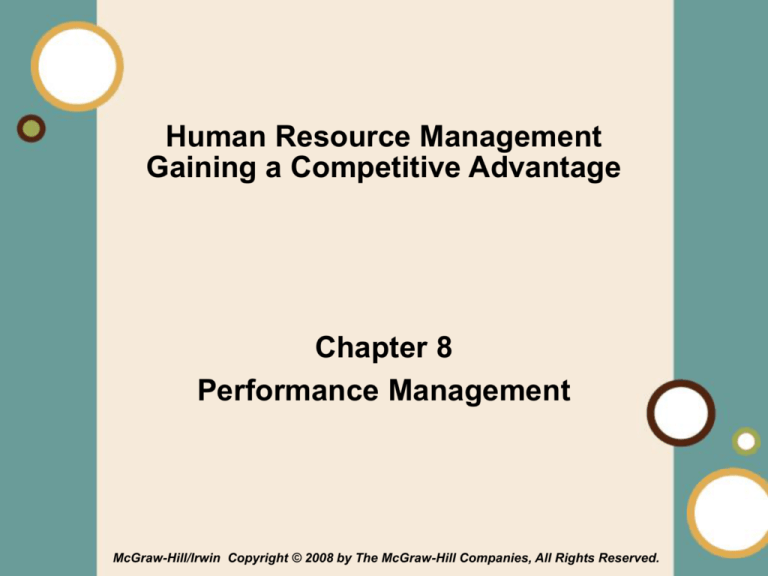
Human Resource Management
Gaining a Competitive Advantage
Chapter 8
Performance Management
McGraw-Hill/Irwin Copyright © 2008 by The McGraw-Hill Companies, All Rights Reserved.
1-1
Learning Objectives
After reading this chapter, you should be able to:
• Identify the major determinants of individual performance.
• Discuss the three general purposes of performance
management.
• Identify the five criteria for effective performance
management systems.
• Discuss the four approaches to performance
management, the specific techniques used in each
approach, and the way these approaches compare with
the criteria for effective performance management
systems.
8-2
Learning Objectives
After reading this chapter, you should be able to:
• Choose the most effective approach to performance
measurement for a given situation.
• Discuss the advantages and disadvantages of the
different sources of performance information.
• Choose the most effective source(s) for performance
information for any situation.
• Distinguish types of rating errors and explain how to
minimize each in a performance evaluation.
• Conduct an effective performance feedback session.
• Identify the cause of a performance problem.
8-3
Introduction
• Performance management is the process
through which managers ensure that
employees’ activities and outputs are congruent
with the organization's goals.
• Performance Appraisal is the process through
which an organization gets information on how
well an employee is doing his or her job.
• Performance Feedback is the process of
providing employees information regarding their
performance effectiveness.
8-4
An Organizational Model of
Performance Management
Organizational
Strategy
Long and short
term goals
and values
Individual
Attributes
(skills, abilities)
Individual
Behaviors
Objective
Results
Situational
Constraints
Culture and
economic
conditions
8-5
Purposes of Performance
Management
Strategic
Administrative
Developmental
8-6
Performance Measures Criteria
Five performance criteria stand out:
Strategic congruence
Specificity
Acceptability
Validity
Reliability
8-7
The Comparative Approach
• Ranking
– Simple ranking ranks employees from
highest to lowest performer.
– Alternation ranking - crossing off the best
and worst employees.
• Forced distribution
– Employees are ranked in groups.
• Paired comparison
– Managers compare every employee with
every other employee in the work group.
8-8
The Attribute Approach
• Graphic rating scales
– A list of traits is evaluated by
a five-point rating scale.
– Legally questionable.
• Mixed-standard scales
– Define relevant performance
dimensions and then develop
statements representing
good, average, and poor
performance along each
dimension.
8-9
Behavioral Approach
• Critical incidents approach - requires managers
to keep record of specific examples of effective
and ineffective performance.
• Behaviorally anchored rating scales (BARS)
• Behavioral observation scales (BOS)
• Organizational behavior modification - a formal
system of behavioral feedback and
reinforcement.
• Assessment centers - multiple raters evaluate
employees’ performance on a number of
exercises.
8-10
Results Approach
• Management by objectives
– top management passes
down company’s strategic
goals to next layer of
management, and these
managers define the goals
they must achieve.
• Productivity Measurement and
Evaluation System (ProMES)
– goal is to motivate employees
to higher levels of productivity.
Goals
Hierarchy
8-11
Quality Approach
• A performance management system designed
with a strong quality orientation can be
expected to:
– Emphasize an assessment of both person and
system factors in the measurement system.
– Emphasize that managers and employees work
together to solve performance problems.
– Involve both internal and external customers in
setting standards and measuring performance.
– Use multiple sources to evaluate person and
system factors.
8-12
Quality Approach (cont.)
• Statistical process quality
control techniques used:
–
–
–
–
–
–
Process-flow analysis
Cause-and-effect diagrams
Pareto chart
Control chart
Histogram
Scattergram
8-13
Sources for Performance
Information
Managers
Customers
Peers
Self
Subordinates
8-14
Rater Errors in Performance
Measurement
• Similar to me
• Contrast
• Distributional
errors
• Halo and horns
8-15
Reducing Rater Errors and
Appraisal Politics
• Two Approaches to reducing rater error:
– Rater error training
– Rater accuracy training
• Appraisal politics - a situation in which
evaluators purposefully distort ratings to
achieve personal or company goals.
8-16
Improving Performance
Feedback
• Feedback should be given frequently,
not once a year.
• Create the right context for the
discussion.
• Ask employee to rate his or her
performance before the session.
• Encourage the subordinate to participate
in the session.
8-17
Improving Performance
Feedback
• Recognize effective performance
through praise.
• Focus on solving problems.
• Focus feedback on behavior or results,
not on the person.
• Minimize criticism.
• Agree to specific goals and set a date
to review progress.
8-18
Factors to Consider in Analyzing
Poor Performance
•
•
•
•
•
Input
Employee characteristics
Feedback
Performance standards/Goals
Consequences
8-19
Managing Performance of
Marginal Performers
• Solid performers
– High ability and motivation; managers should
provide development opportunities
• Misdirected effort
– Lack of ability but high motivation; managers
should focus on training
• Underutilizers
– High ability but lack motivation; managers
should focus on interpersonal abilities
• Deadwood
– Low ability and motivation; managerial
action, outplacement, demotion, firing.
8-20
Following Legal Guidelines
• Conduct a valid job analysis related to
performance.
• Base system on specific behaviors or
results.
• Train raters to use system correctly.
• Review performance ratings and allow
for employee appeal.
• Provide guidance/support for poor
performers.
• Use multiple raters.
8-21
Use of Technology for
Performance Management
• Electronic tracking systems includes:
– Hand and fingerprint recognition systems
– Global positioning systems (GPS)
– Systems that can track employees using
handheld computers and cell phones
• Increased productivity can be a benefit
from these systems.
• These systems present privacy
concerns.
8-22

